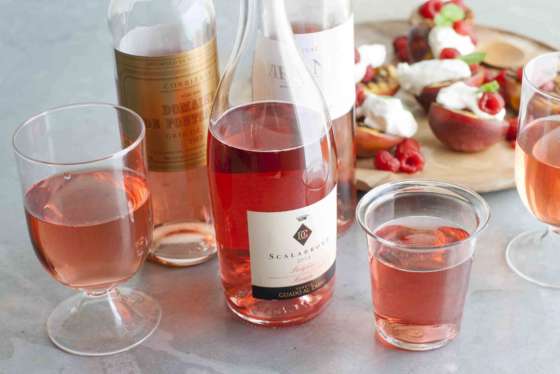WASHINGTON — I can only imagine the following conversation taking place at some well-heeled club in a posh Kensington neighborhood in London:
First Englishman: I say, ‘ol boy, be a decent chap and pass the Champagne. I’m absolutely parched!
Second Englishman: I would love to, but I’m afraid you’re mistaken. This is English sparkling wine, not Champagne.
First Englishman: The hell, you say? What do you mean it’s not Champagne? It looks exactly like Champagne! What would Churchill say?
I’m not sure if the British really speak this way, but that’s how I pictured it in my mind while tasting my way through four English sparkling wines last week.
Yes, that tiny island in the sea, land of kings and queens, is now making wine. And not just any wine. England is making reasonably priced sparkling wine that’s getting a lot of attention around the world.
It turns out England’s southern coastal region has a lot in common with its long-lost cousin, Champagne. (It’s theorized that at some point in the very distant past — think millennium — the island was once connected to the continent of Europe.)
After the big breakup, France went on to become a star on the winemaking circuit and Great Britain decided to rule the world. Obviously, France had a longer career …
However, the southern coast of England, where the majority of viticulture is centered, kept a small memento from its affair with Europe, namely the limestone chalky, loamy soils that chardonnay, pinot noir and pinot meunier adore so much.
With a little help from global warming, the climate has become slightly warmer and drier, with its average annual temperatures on the rise.
While this may be bad news for our polar ice caps, it has been a gift to wine growers who have prayed for a day when their grapes could ripen and achieve phenolic maturity.
Today, new wineries are finding a home all along the southern strip of England’s coast. From Kent to Cornwall, winemakers are turning out some of the best sparkling wines on their side of the English Channel. The three major regions in the South include Sussex, Kent and Surrey, where wines made using the traditional Methode Champenoise are being produced for both domestic consumption and export.
Perhaps what is even more remarkable is that the French have actually taken notice. Just a few years ago, the famous Champagne house, Taittinger, became the first Champagne producer to jump on the English sparkling wine bandwagon, purchasing land in Kent where they intend to grow chardonnay, pinot noir and pinot meunier on its new land.
Not to be outdone, Champagne Pommery has planted roots in Surrey, where the chalky soils are made up of the remains of ancient marine fossils. This is perfect for developing wines with character and ageability.
But the real test is in the glass, and these four British sparklers left me amazed.
The Digby brand is named in honor of Sir Kenelm Digby, a 17th century English philosopher, theologian, pirate and writer, who is credited with inventing the modern wine bottle. The good news is the stuff inside the bottle is also worthy of his name. The 2010 Digby Fine English Reserve Brut from the Sussex region of England is a blend of chardonnay, pinot noir and pinot meunier. The tiny, precise bubbles add a certain degree of elegance as they deliver lovely notes of apple, pear, citrus and roasted almonds across the entire palate. Toasted hazelnuts are featured on the crisp, balanced finish. $50
With a history dating back to 1503, the exquisite Tudor-framed Hush Heath Manor is the family home of the Balfour-Lynn’s since the 1980s. Winemaking began in earnest in 2002, when Richard Balfour-Lynn planted his first vineyards on these clay-rich soils with an ambition to make fine sparkling rosé. The mission has been accomplished with the Nonvintage Hush Heath Estate Balfour Brut Rose. The delicate pink color is accompanied by lovely scents of sweet cherry, vibrant strawberry and chalky mineral. Bright black cherry, strawberry and red plum fruit flavors offer surprising depth. Mouthwatering mineral-laden acidity mesh with hints of white pepper and baking spices on the beautiful finish. $60
The first English house to produce sparkling wine, Nyetimber, has been at the game for 25 years. And it shows in the Nyetimber Classic Cuvee, a blend of chardonnay, pinot noir and pinot meunier. It offers up scents of roasted nuts and baked bread on the nose. The palate is full-bodied, fresh and vivacious, with flavors of Honey Crisp apple, pear, and citrus fruit with a hint of dough. $35
Tucked away down in Cornwall, at the southwestern tip of England, lies one of the country’s most exciting wineries. Camel Valley Vineyards was started by former Royal Air Force pilot Bob Lindo and his wife, Annie, on their farm in 1989 when the phrase “English wine” was an oxymoron. Their self-taught hard work and vision has been rewarded with a steady string of accolades, including several for their Nonvintage Camel Valley Pinot Noir Brut that wins the palate over with intensity and charm. The nose abounds with fresh summer orchard fruits and citrus peel. The creamy mouthfeel is layered with flavors of honeysuckle and brioche on the nose and flavors of apple, white peach, orange blossom and baked bread on the palate. The long finish has a slightly lemony-creamy feel that adds a nice level of elegance.
There is an underlying spice of white pepper and fresh herbs over a slice of lemon poundcake. The palate is aggressive with high toned notes of green apple and grapefruit moving with extended notes of ripe pears and gooseberries. The finish is not massive but it is persistent with a peppery, herbal tone carrying throughout. $50








